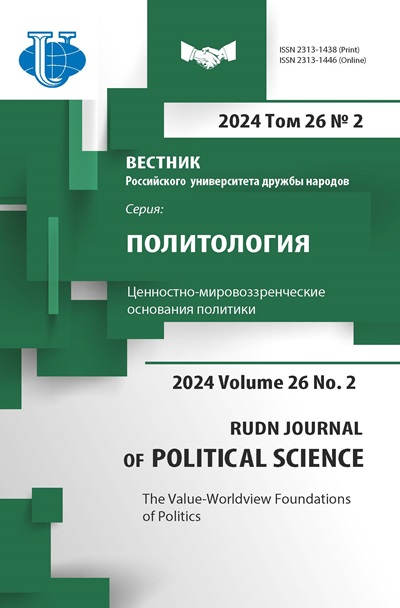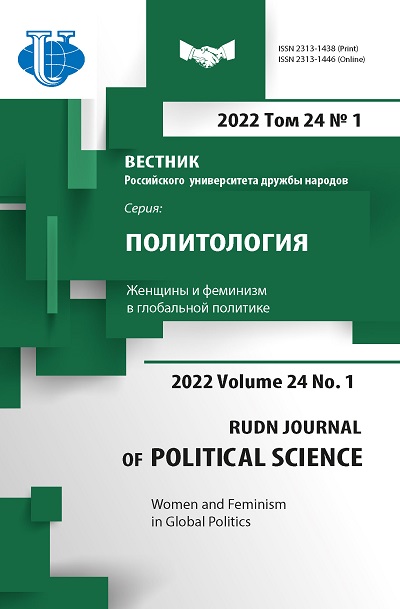Как цифровая политика ООН может способствовать реализации прав женщин
- Авторы: Линдерс А.Р.1,2
-
Учреждения:
- Софийский университет
- Московский государственный институт международных отношений (университет) Министерства иностранных дел Российской Федерации
- Выпуск: Том 24, № 1 (2022): Женщины и феминизм в глобальной политике
- Страницы: 53-63
- Раздел: ФЕМИНИЗМ КАК ИДЕОЛОГИЯ И КОНЦЕПТУАЛЬНОЕ ОСНОВАНИЕ ПОЛИТИКИ
- URL: https://journals.rudn.ru/political-science/article/view/30315
- DOI: https://doi.org/10.22363/2313-1438-2022-24-1-53-63
Цитировать
Полный текст
Аннотация
В академической литературе программы и инициативы ООН по продвижению цифровизации и защите прав женщин обычно изучаются отдельно. Меньше внимания уделяется усилиям ООН по продвижению гендерного равенства и защите прав женщин путем продвижения цифровых технологий. В статье восполняются некоторые пробелы в современных исследованиях вклада современных международных межправительственных организаций в защиту прав женщин в современных условиях технологического развития. Выявлено влияние процессов цифровизации на улучшение положения женщин в современных обществах за счет обеспечения прав женщин. Представлена оценка проблемы гендерного разрыва в использовании ИКТ-технологий. Установлено, что в Целях устойчивого развития (ЦУР), утвержденных ООН в 2015 году, недостаточно внимания уделяется важности цифровизации для обеспечения прав женщин. Анализируются различные формы деятельности специализированных подразделений ООН, обеспечивающих цифровое гендерное равенство.
Ключевые слова
Об авторах
Анна Мария Рада Линдерс
Софийский университет; Московский государственный институт международных отношений (университет) Министерства иностранных дел Российской Федерации
Автор, ответственный за переписку.
Email: amrada4@mail.ru
ORCID iD: 0000-0001-7356-1456
магистр политологии Колумбийского университета, преподаватель Софийского университета, аспирант МГИМО МИД России
София, Республика Болгария; Москва, Российская ФедерацияСписок литературы
- Alves, J.E.D. (2016). Desafios da equidade de gênero no século XXI. Revista Estudos Feministas, 24(2), 629-638. https://doi.org/10.1590/1805-9584-2016v24n2p629
- Arat, Z.F.K. (2015). Feminisms, Women’s Rights, and the UN: Would Achieving Gender Equality Empower Women? American Political Science Review, 109(4), 674-689. https://doi.org/10.1017/s0003055415000386
- Dhar, S. (2018). Gender and Sustainable Development Goals (SDGs). Indian Journal of Gender Studies, 25(1), 47-78. https://doi.org/10.1177/0971521517738451
- Gilleri, G. (2020). ‘How are you actually doing, ladies?’ Indicators of gender equality through the lens of the UN Committee on the Elimination of Discrimination against Women. International Journal of Human Rights, 24(8), 1218-1246. https://doi.org/10.1080/13642987.2020.1717474
- Girard, M. (2020). We Need Standards for Digital Cooperation to Occur. IEEE Technology and Society Magazine, 39(2), 68-74. https://doi.org/10.1109/MTS.2020.2991501
- Herr, R.S. (2019). Women’s Rights as Human Rights and Cultural Imperialism. Feminist Formations, 31(3), 118-142. https://doi.org/10.1353/ff.2019.0033
- Kim, E.M. (2017). Gender and the Sustainable Development Goals. Global Social Policy, 17(2), 239-244. https://doi.org/10.1177/1468018117703444
- Kleinwächter, W., Kettemann, M.C., & Senges, M. (Eds.). (2019). Towards a Global Framework for Cyber Peace and Digital Cooperation: An Agenda for the 2020s. Hamburg: Verlag Hans-Bredow-Institut.
- Leenders, A.M. (2020). International relations and technological conditionality. The Caspian Region: Politics, Economics, Culture, 1, 96-104. https://doi.org/10.21672/1818-510X-2020-62-1-096-104 (In Russian).
- Leenders, A.M., & Grishin, N. (2020). United Nations institutions for the development of digital cooperation. Political Expertise: POLITEX, 16(4), 493-504. https://doi.org/10.21638/spbu23.2020.405 (In Russian).
- MacPhail, F. (2017). Progress of the world’s women 2015-2016: transforming economies, realizing rights, by UN Women. Canadian Journal of Development Studies/Revue canadienne d’études du développement, 38(2), 1-3. https://doi.org/10.1080/02255189.2017.1303366
- McQuigg, R. (2018). Is it time for an UN treaty on violence against women? The International Journal of Human Rights, 22(3), 305-324. https://doi.org/10.1080/13642987.2017.1359552
- Popova, O.V., Maslova, A.E., & Agapitova, M.I. (2016). Problems of reproductive health of women and abortions in programs of the Russian political parties. The Woman in the Russian society, 4(81), 72-84. https://doi.org/10.21064/WinRS.2016.4.6 (In Russian).
- Prestes, E. (2019). An Overview of the United Nations High-Level Panel on Digital Cooperation. IEEE Robotics & Automation Magazine, 26(1), 103-104. https://doi.org/10.1109/MRA.2019.2891183
- Renzulli, I. (2017). ‘Women and peace’: A human rights strategy for the women, peace and security agenda. Netherlands Quarterly of Human Rights, 35(4), 210-229. https://doi.org/10.1177/0924051917737912
- Sandler, J., & Goetz, A.M. (2020). Can the United Nations deliver a feminist future? Gender & Development, 28(2), 239-263. https://doi.org/10.1080/13552074.2020.1753432
- Zipoli, D. (2019). NHRI Engagement with UN Human Rights Treaty Bodies: A Goal-based Approach. Nordic Journal of Human Rights, 37(3), 259-280. https://doi.org/10.1080/18918131.2019.1682241
















